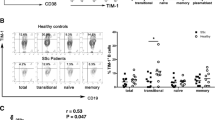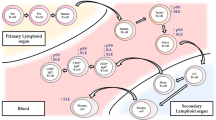Abstract
This study was designed to investigate the functional heterogeneity of human Th17 and how their plasticity shapes the nature of immune cell responses to inflammation and autoimmune diseases, such as systemic lupus erythematosus (SLE). We evaluated functional Th17 cell subsets based on the profile of cytokine production in peripheral blood (PB), bone marrow aspirates (BM) and lymph node biopsies (LN) from healthy individuals (n = 35) and PB from SLE patients (n = 34). Data were analysed by an automated method for merging and calculation of flow cytometric data, allowing us to identify eight Th17 subpopulations. Normal BM presented lower frequencies of Th17 (p = 0.006 and p = 0.05) and lower amount of IL-17 per cell (p = 0.03 and p = 0.02), compared to normal PB and LN biopsies. In the latter tissues were found increased proportions of Th17 producing TNF-α or TNF-α/IL-2 or IFN-γ/TNF-α/IL-2, while in BM, Th17 producing other cytokines than IL-17 was clearly decreased. In SLE patients, the frequency of Th17 was higher than in control, but the levels of IL-17 per cell were significantly reduced (p < 0.05). Among the eight generated subpopulations, despite the great functional heterogeneity of Th17 in SLE, a significant low proportion of Th17 producing TNF-α was found in inactive SLE, while active SLE showed a high proportion producing only IL-17. Our findings support the idea that the functional heterogeneity of Th17 cells could depend on the cytokine microenvironment, which is distinct in normal BM as well as in active SLE, probably due to a Th1/Th2 imbalance previously reported by our group.



Similar content being viewed by others
References
Harrington LE, Mangan PR, Weaver CT (2006) Expanding the effector CD4 T-cell repertoire: the Th17 lineage. Curr Opin Immunol 18:349–356
Harrington LE, Hatton RD, Mangan PR et al (2005) Interleukin 17-producing CD4+ effector T cells develop via a lineage distinct from the T helper type 1 and 2 lineages. Nat Immunol 6:1123–1132
Park H, Li Z, Yang XO et al (2005) A distinct lineage of CD4 T cells regulates tissue inflammation by producing interleukin 17. Nat Immunol 11:1133–1141
Shi G, Cox CA, Vistica BP, Tan C, Wawrousek EF, Gery I (2008) Phenotype switching by inflammation-inducing polarized Th17 cells, but not by Th1 cells. J Immunol 181:7205–7213
Lee YK, Turner H, Maynard CL et al (2009) Late developmental plasticity in the T helper 17 lineage. Immunity 30:92–107
Lexberg MH, Taubner A, Albrecht I et al (2010) IFN-γ and IL-12 synergize to convert in vivo generated Th17 into Th1/Th17 cells. Eur J Immunol 40:3017–3027
Yang XO et al (2008) Molecular antagonism and plasticity of regulatory and inflammatory T cell programs. Immunity 29:44–56
Walline CC, Kanakasabai S, Bright JJ (2011) IL-7Rα confers susceptibility to experimental autoimmune encephalomyelitis. Genes Immun 12:1–14
Miossec P (2003) Interleukin-17 in rheumatoid arthritis: if T cells were to contribute to inflammation and destruction through synergy. Arthritis Rheum 48:594–601
RL Van bezooijen, Farih-Sips HC, Papapoulos SE, Lowik CW (1999) Interleukin-17: a new bone acting cytokine in vitro. J Bone Miner Res 14:1513–1521
Shih DQ, Targan SR, McGovern D (2008) Recent advances in IBD pathogenesis: genetics and immunobiology. Curr Gastroenterol Rep 10:568–575
Kurasawa K, Hirose K, Sano H et al (2000) Increased interleukin-17 production in patients with systemic sclerosis. Arthritis Rheum 43:2455–2463
Crispin JC, Oukka M, Bayliss G et al (2008) Expanded double negative T cells in patients with systemic lupus erythematosus produce IL-17 and infiltrate the kidneys. J Immunol 181:8761–8766
Wong CK, Lit LC, Tam LS, Li EK, Wong PT, Lam CW (2008) Hyperproduction of IL-23 and IL-17 in patients with systemic lupus erythematosus: implications for Th17-mediated inflammation in auto-immunity. Clin Immunol 127:385–393
Dardalhon V, Korn T, Kuchroo VK, Anderson AC (2008) Role of Th1 and Th17 cells in organ-specific autoimmunity. J Autoimmun 31:252–256
Annunziato F, Cosmi L, Santarlasci V et al (2007) Phenotypic and functional features of human Th17 cells. J Exp Med 204:1849–1861
Pedreira CE, Costa ES, Barrena S et al (2008) Generation of flow cytometry data files with a potentially infinite number of dimensions. EuroFlow Consortium. Cytometry A 73:834–846
Hochberg MC (1997) Updating the American College of Rheumatology revised criteria for the classification of systemic lupus erythematosus. Arthritis Rheum 40:1725
Bombardier C, Gladman DD, Urowitz MB, Caron D, Chang CH (1992) Derivation of the SLEDAI. A disease activity index for lupus patients. The Committee on Prognosis Studies in SLE. Arthritis Rheum 35:630–640
Gladman DD, Ibanez D, Urowitz MB (2002) Systemic lupus erythematosus disease activity index 2000. J Rheumatol 29:288–291
Griffiths B, Mosca M, Gordon C (2005) Assessment of patients with systemic lupus erythematosus and the use of lupus disease activity indices. Best Pract Res Clin Rheumatol 19:685–708
Yang Y, Weiner J, Liu Y et al (2009) T-bet is essential for encephalitogenicity of both Th1 and Th17 cells. J Exp Med 206:1549–1564
Evans HG, Suddason T, Jackson I, Taams LS, Lord GM (2007) Optimal induction of T helper 17 cells in humans requires T cell receptor ligation in the context of toll-like receptor-activated monocytes. Proc Natl Acad Sci U S A 104:17034–17039
Garrett-Sinha LA, John S, Gaffen SL (2008) IL-17 and the Th17 lineage in systemic lupus erythematosus. Curr Opin Rheumatol 20:519–525
Mackenzie BS, Kastelein RA, Cua DJ (2006) Understanding the IL-23-IL-17 immune pathway. Trends Immunol 27:17–23
Zhou L, Chong MM, Littman DR (2009) Plasticity of CD4+ T cell lineage differentiation. Immunity 30:646–655
Shen F, Gaffen SL (2008) Structure-function relationships in the IL-17 receptor: implications for signal transduction and therapy. Cytokine 41:92–104
Henriques A, Inês L, Couto M et al (2010) Frequency and functional activity of Th17, Tc17 and other T cell subsets in systemic lupus erythematosus. Cell Immunol 264:97–103
Ermann J, Bermas BL (2007) The biology behind the new therapies for SLE. Int J Clin Pract 61:2113–2119
Ramirez F, Fowell DJ, Puklavec M, Simmonds S, Mason D (1996) Glucocorticoids promote a TH2 cytokine response by CD4+ T cells in vitro. J Immunol 156:2406–2412
Akahoshi M, Nakashima H, Tanaka Y et al (1999) Th1/Th2 balance of peripheral T helper cells in systemic lupus erythematosus. Arthritis Rheum 42:1644–1648
Chen S, Hu D, Shi X, Shen N, Gu Y, Bao C (2000) The relationship between Th1/Th2-type cells and disease activity in patients with systemic lupus erythematosus. Chin Med J 113:877–880
Disclosures
None.
Author information
Authors and Affiliations
Corresponding author
Additional information
Ana Henriques and Luís Inês contributed equally to this work.
Rights and permissions
About this article
Cite this article
Henriques, A., Inês, L., Pais, M.L. et al. Th17 cells in systemic lupus erythematosus share functional features with Th17 cells from normal bone marrow and peripheral tissues. Clin Rheumatol 31, 483–491 (2012). https://doi.org/10.1007/s10067-011-1860-9
Received:
Revised:
Accepted:
Published:
Issue Date:
DOI: https://doi.org/10.1007/s10067-011-1860-9




